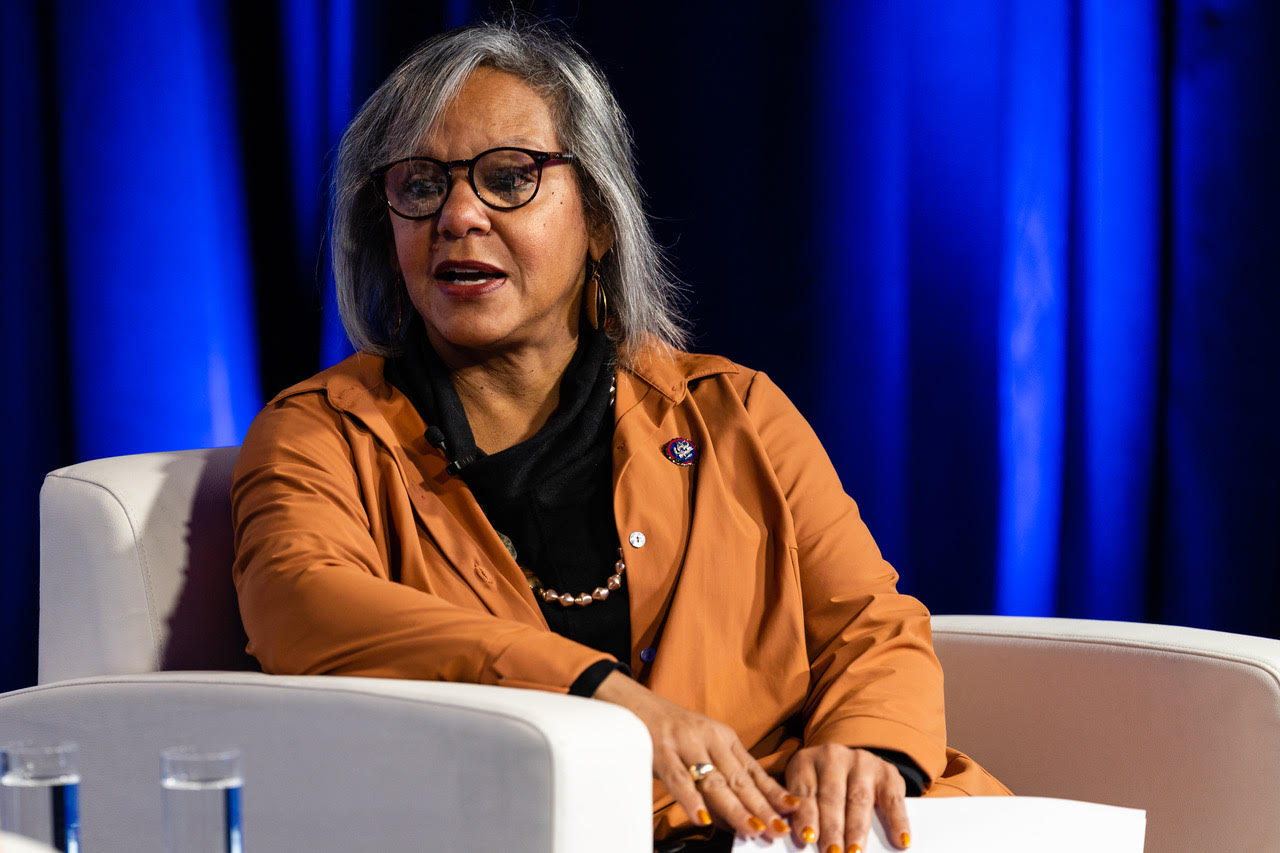Washington, DC–(ENEWSPF)–March 14, 2014 – 1:41 P.M. EDT
MRS. OBAMA: Yay to everyone! (Applause.) Thank you so much. You all, rest yourselves. It is a pleasure to be here with all of you today.
Let me start by thanking Larry, not just for his very kind introduction but for his outstanding leadership at PHA, as well as the entire staff of PHA, the board, Jim Gavin — all of you deserve a huge round of applause for your outstanding work. I’m so proud of you all. Thank you so much. (Applause.) PHA is doing critically important work to engage partners across the private sector, and over the past two days we’ve seen the fruits of their efforts.
And I am thrilled about the extraordinary commitments that have been announced at this summit, so I want to take a moment to recognize Dannon, Del Monte, Knowledge Universe, Kwik Trip, Nutri Ventures, and Sodexo. So let’s give them another huge round of applause. (Applause.) These are major steps to making sure our families can lead healthier lives, and we are extremely grateful.
And of course, I want to thank all of you, the advocates and experts who’ve been working on the issue of childhood obesity long before it came into the national spotlight. You all are truly our brain trust on this issue. You know better than anyone where we’ve been and where we need to go. And that’s really what I want to talk about today. I want to talk about how much we’ve achieved, but more importantly, how much more we have left to do.
So let’s start with the good news: Because of what we have all done together, today, 32 million kids are getting healthier school meals. Tens of thousands of schools are removing junk food ads from their classroom. Fifteen thousand childcare centers will be providing healthier snacks and getting those cute little kids up and moving. Food and beverage companies have cut 6.4 trillion calories from their products. We will soon have better nutrition labels on 700,000 food items. Hundreds of new or renovated grocery stores are reaching millions of people in underserved communities — I could go on. These are just a few of the highlights. Absolutely amazing. (Applause.)
And today, slowly but surely, healthy habits are becoming the new norm in this country. Today, according to a recent CDC report that I know you have all discussed, obesity rates have fallen by 43 percent among children ages two to five years old. And I think we should all be very proud of what we are achieving together, because in a fight this hard, we should celebrate every small victory we can get.
But that’s really what the CDC report represents. Yes, it is an important achievement, but in light of the magnitude of this challenge, it is a small achievement. It’s just a hint of the progress that’s possible on this issue. So it is a very good thing that we have got so much momentum right now, because we still have a long way to go to solve this problem, particularly among our older children.
So now is not the time to take our foot off the gas and congratulate ourselves on a job well done — just the opposite. Now is the time to fight even harder, because we now know it is possible to make a difference on this issue. We know that our strategies are beginning to work.
So through Let’s Move, we plan to keep attacking this problem from every angle, because we know there is no one magic bullet. So we plan to keep building healthier schools. We plan to keep bringing fresh food into our communities. We plan to keep urging businesses to provide healthy products and market them responsibly to our kids. But we also need to keep innovating. We need to keep pushing the envelope. We need to find new ideas from every sector to help families make manageable, affordable changes that can transform our children’s health.
And today, I just want to talk briefly to give an example of one of those changes. It’s a simple idea which will be a key focus of Let’s Move over the next year, but it is an idea that can help families create healthier new habits. And the idea is to help families start cooking again.
Now, I know this might not seem like an earth-shattering notion — though neither was planting a garden in the White House, I will remind you. (Laughter.) But research clearly shows that home-cooking is one of the single most impactful ways for families to improve their health.
One study shows that home-cooking is actually a better predictor of how well families eat than their income. And that’s not surprising, because food prepared at home is lower in saturated fat, sodium, cholesterol and calories than food prepared away from home. Because when you cook at home, you’re in control of your nutrition. You decide the ingredients to use. You decide the portion sizes. You decide whether there’s a vegetable on the plate or not.
But unfortunately, for many families, home-cooking has fallen by the wayside. And many folks feel like they just don’t have the time to cook, or they don’t know how. Some think it’s more expensive to prepare balanced home-cooked meals, so they don’t do it. But it hasn’t always been that way.
See, back in the day — for you young people, the day is, like, when I was young — (laughter) — folks used to cook all the time. That was certainly true in my family growing up. My mother had a strict food budget, and every Saturday she wrote out her list for the week, headed to the grocery down the street. And she had every meal planned out for the week -– that roast beef for Sunday dinner would be sandwiches for Monday and Tuesday lunches. Wednesday night was liver night — it was a very sad night in our household, by the way. (Laughter.) Thursday might be spaghetti; Friday, fish. And once in great a while, we’d order a pizza or pick up a burger at the drive-through, but we usually couldn’t afford to eat out so those were exceptions.
My grandmother had done the same thing for her family, and she worked full-time for most of her life. See, back then, unless you were rich, cooking was a matter of survival. It was a way of life. But like a lot of folks in my generation, I found that by the time I grew up and went off to school and started my career, things had changed.
I remember one Saturday afternoon as a young lawyer working crazy hours, I was talking to my grandmother over the phone, and the first thing she asked me, she said, “what are you cooking?” I was like, “Grandma, really? I am a lawyer. I do not cook.” (Laughter.)
You see, my parents urged me to focus on my studies and career above all else. They had worked hard to support my dreams, so they didn’t want me to worry about traditional things like cooking. They felt like I could always learn to cook later. And that was all well and good for a while, until I had a family of my own.
And I was fine when my kids were little, because we went from breastfeeding straight to what Barack and I called the “jar stage” — when an entire meal for a baby came in a single jar. Barack and I, we loved the “jar stage.” (Laughter.) We were masters of the “jar stage.” Providing a balanced meal was so easy — chicken and rice? In a jar. Peas and spinach? Jar. Peaches, bananas? Jar — big jar. No need to cook, boil, bake, it was all there for us in those marvelous little baby food jars. It was heaven.
But then our babies outgrew the “jar stage,” and suddenly we were faced with the reality that we might actually have to use the appliances in our kitchen to feed our children. And we slowly figured it out. We started with the basics like broiled chicken and rice, and steamed broccoli, scrambled eggs — that’s really all Barack would do, the eggs. (Laughter.) And we did our best to cook regularly at home. But like so many working parents, we both had demanding jobs, we were always exhausted. And over time, we started giving in and popping things into the microwave, or spending way too much of our monthly budget ordering takeout, which, in turn, resulted in less than optimal health outcomes for our kids.
So as my story hopefully illustrates, while we often frame this cooking problem as a time problem or a budget problem, for many folks it’s actually a skills problem. Because when you don’t have those basic cooking and budgeting skills that my mother and grandmother had, everything takes longer and costs much more.
You don’t know how to plan a full week of meals, so you go back and forth to the grocery store. You don’t know how to cut a whole chicken yourself, so you pay more for the pre-cut parts. You’ve never learned the basics of cooking, so even simple dishes take longer to prepare. And today, a lot of folks think it’s quicker and cheaper to just grab some fast food.
But the fact is that with the right recipes and a few basic skills, there are countless recipes that families can prepare in less than 30 minutes –- meals that actually cost less than going to the drive-through. For example, a fast food meal for a family of four could cost as much as $20, $25 or more. But for less than $15, a family can cook a full chicken dinner complete with sides.
And cooking isn’t just good for our budgets or our physical health, it’s also good for our kids’ emotional health. Research shows that when families share meals together, kids actually perform better in school, and they get along better with their peers. And let’s not forget that cooking together can actually be fun.
So the benefits of cooking couldn’t be more clear. The question is how do we help families start cooking again, even if it’s just one or two meals a week? Can we work with supermarkets to do more to distribute recipes on how to cook, and do demonstrations? Can we develop the home-ec class of the future that will give kids — both girls and boys –- the basic skills they need to feed themselves on a budget? Can we inspire chefs to offer affordable cooking classes in their restaurants?
I mean, the possibilities here are endless. And in the coming months, as we continue our existing efforts, we will be announcing some new initiatives along these lines.
But really, this is just one example of a very simple, creative approach that doesn’t require new legislation but can fundamentally change the way families take control of their own health. And I know, looking around this room, that all of you have some great ideas of your own; many innovative, creative things to keep moving this issue forward.
And that’s why today, more than ever before, we need you all with us in this effort. We need everyone in this room to keep tackling this problem from every angle, because we are just beginning to get traction on this issue. After decades of struggle, we are just beginning to make some progress. And I am proud of what we’ve achieved together.
But when one in three children in this country are still overweight or obese, when millions of kids are still on track to develop devastating illnesses like diabetes and heart disease, then we still have to do a gut check. We need to ask ourselves, have we really done all that we can for our children? Have we given them our very best?
And of course, the answer is, not really. The truth is that right now, the biggest risk to our success is our own impatience, our desire to want big changes overnight. Just think back to our first PHA Summit four years ago — I don’t know how many of you were there — I was there. (Laughter.) And I still remember all the excitement and determination we were feeling that day. We didn’t listen to the skeptics who said we could never solve a problem this big and entrenched. Instead, we all committed ourselves to one clear goal, and that was to solve the problem of childhood obesity within a generation so that kids born today will grow up healthy.
Now, this wasn’t a five-year goal or a ten-year goal. It was a generational goal, because it took decades for this childhood-obesity crisis to develop and we knew it would take decades to fix it. And today, just four years later, studies are beginning to show that our youngest kids –- kids born two to five years ago — are growing up healthier.
So we’re on track to achieve our goal, we are. (Applause.) We are on track. But if we back down now, if we don’t keep innovating and pushing forward, I guarantee you that we will go right back to where we started. And that’s not who we are. That’s not what we do in this country.
We don’t just walk away when things get hard, especially when it comes to our children’s future. And we cannot walk away from this issue until obesity rates drop for children of every age and every background. We cannot walk away until every child in this country has a shot at a healthy life. And that’s why I’m in this for the long haul — and I mean long after I leave the White House. Because I believe in finishing what I start, and I know that you all do too. (Applause.)
So now is the time for all of us to truly double down. Now is the time to commit more effort, more innovation, more energy, more dollars, and more leadership to solving this problem. That’s what I plan on doing, and if you continue to join me in this effort, if you keep on digging deep and pushing forward, then I know we can raise healthier kids who will become healthier adults, who will raise healthier families of their own.
And that’s how we make real and lasting change in this country. That’s how we create a better future for generations to come. So I look forward to working with all of you to create that future that we know we can achieve in the months and years ahead.
So thank you all. Thank you for everything you’ve done. Thank you for everything you continue to do. I am so proud of you all. God bless. (Applause.)
END
1:58 P.M. EDT
Source: whitehouse.gov








